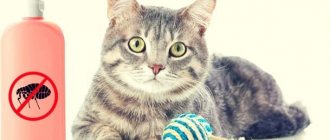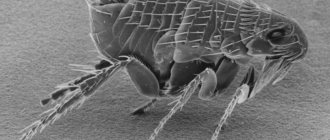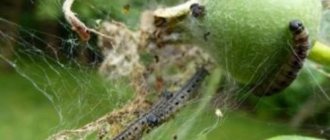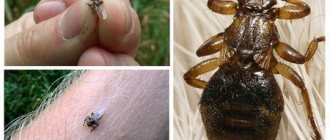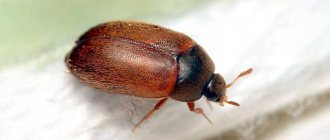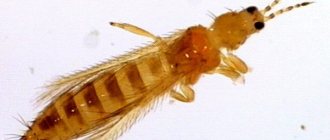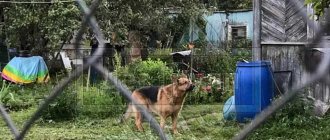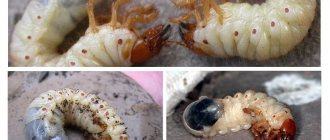Appearance and life cycle of grass fleas
They are also called psyllids, as they prefer to settle on deciduous trees, shrubs, vegetable and flower crops. The population includes more than 1000 species, 200 of which inhabit European countries.
These are tiny sucking creatures from 1 to 5 mm in length with transparent membranous wings folded in the form of a roof on the back, a flattened head with long mustaches, with two large eyes and 3 small defective ones. Adults are equipped with several pairs of legs, the hind ones are more developed, which is why they are able to jump high and far (hence the name “fleas”), and the larvae are inactive.
Lifestyle of grass fleas
Grass fleas appear already in the spring, around April, from under fallen leaves and cracks in the bark, since they are not afraid of winter frosts, just like the egg clutch that the female laid in the fall. One clutch can contain up to 700 eggs measuring 0.3 mm. Bright sunlight and an increase in temperature to +10 accelerates the appearance of larvae feeding on the plant sap.
With the help of a sting, the psyllid caterpillar sucks out a large amount of cell sap, which it is not even able to digest, and removes it from the body in the form of a sticky liquid - honey dew, which is why they are also called honey or honey lice. This shiny coating clogs the pores of the vegetative parts of the plant, facilitating the development of pathogens, in particular sooty fungus, and also attracts other pests, such as ants.
During maturation, the caterpillar molts up to 5 times, only then it degenerates into a nymph. In mid-May, its wings appear.
After 2 weeks, the nymph turns into a small flying grass flea, reminiscent of a cicada, bright green, yellowish-brown or brown (depending on the species) and is ready to reproduce a new generation.
Individuals do not live long:
- the male dies immediately after mating;
- female after 45 days.
During this period, the female psyllid lays eggs on the back of a leaf or on grass stems once a week, up to 90 eggs. The development of an individual lasts from 20 days to 4 weeks.
The insect leads a colonial lifestyle. The grass flea is especially active in the evening and at night in hot, dry weather, so weather conditions play an important role in the development of the population and the fight against it.
Description
The grass flea, or earth flea, is the most common flea that parasitizes warm-blooded animals. It is called grassy due to the fact that it attacks mainly from the ground or from grass thickets, where it often lies in wait for its prey. Insects belong to the family Hemiptera. Their main food is the sap of plants, bushes and trees. There are three stages of pest development:
- Larva;
- Nymph;
- Adult insect.
Insects appear in April. They cause inconvenience in vegetable gardens, orchards and in a person’s home until about mid-summer. Grass fleas must be destroyed by this time, before the female has time to lay eggs.
ATTENTION: Like any parasite, the grass flea spreads infection.
Fleas have a flat body, which allows them to easily crawl into warm rooms through small cracks and cracks in walls and floors. The fore wings are much darker than the hind wings. An adult flea is no more than three millimeters in length.
Varieties of grass fleas
About 100 species are widespread in Russia. Some of them cause damage to agricultural crops, for example:
- Stem cereals (genus Chaetocnema aridula and Chaetocnema hortensis) – affecting winter and spring crops even at the stage of germination and formation of stems, many species of this genus are also dangerous for sugar beets;
- striped flea beetle (Phillotreta vittula) - a thunderstorm of cruciferous plants;
- blue and black flax flea beetles are capable of destroying flax crops in a matter of days and repeatedly during the season;
- hemp flea beetle (Psylliodes attenuate Koh) - causes harm not only to mulberries, but also to hops.
Gardeners are well aware of the grass fleas that attack fruit, berry and vegetable plantings:
- common and large pear honeydew (Psylla pyricola);
- apple honey beetle (P. mali);
- carrot psyllid (Trioza viridula) – the intermediate host is coniferous trees (overwinters);
- Libya (Livia juncorum) – leaves galls on flower crops, sedges.
In some varieties, only the larvae cause significant harm, and basically all stages of the formation of an individual are dangerous for the development of the plant.
How to get rid of fleas in the house: 5 steps
To remove fleas from an apartment, you need to treat all things step by step, and then the room as a whole. There is a lot of work to be done, but it is worth it to restore peace of mind to your family and pets. The main thing is not to panic, to act systematically. It is necessary to go through five stages to completely treat your apartment for fleas.
- Eliminating the source. First of all, find the place where the invasion began. If these are cracks in the baseboard or windows, seal the holes and make minor repairs. Treat the animal that caused fleas to spread around the apartment with special products - drops, shampoo or spray, and put a flea collar on the dog or cat. Change bedding or cage.
- Dry and wet cleaning. Vacuum all corners, carpets and furniture. It is better to use a vacuum cleaner with a paper bag, which you immediately throw away after cleaning. If dust collects in a plastic container, throw out the contents and rinse the container with boiling water. It is not recommended to use a vacuum cleaner with a fabric bag. After dry cleaning, wipe the floors, window sills, and sink with soap, vinegar or ammonia solution.
- Processing things. Take the carpets outside, beat them well and warm them in the sun, or cover them with snow and leave them for a while. Treat mattresses and furniture upholstery with steam using an iron or steam generator. Wash all the things in the closet, bed linen, towels, bathrobes. Steam coats, jackets, jackets. Beat out the pillows and leave them in the sun. Don't miss a single thing in the house. Everything must be washed, knocked out and cleaned.
- Complete disinfection of the premises. Before treating with poison, it is better to remove household members, including animals, from the apartment. Remove food, take out indoor plants (they should be treated separately), remove bedding. Protect your respiratory tract and eyes with a mask and goggles. Close windows, doors, and ventilation. Apply the chemical to insect nesting areas, such as baseboards around the perimeter of the room. Depending on the product used, let the poison sit for a certain amount of time (indicated on the label), only then ventilate the room.
- Repeated procedure. You should not immediately clean up and wash off the product. Time must pass to ensure that the insects are eliminated. It is possible that after the first treatment, eggs and pupae remained, which will hatch only in a week. If after ten days the peace is not disturbed, no one is bothered by bites, you can begin general cleaning. Newly spotted insects require repeated treatment with poison.
Treat absolutely all rooms (with windows and doors closed), even if fleas live only in the bedroom or bathroom. Local application will not be successful. Insects simply migrate to the next, “clean” room.
The easiest way to quickly get rid of fleas in the house is to call the appropriate service that will poison the annoying insects. If you decide to cope on your own, you should be patient and pedantic. Not a single section of the room should be skipped, otherwise in a week everything will happen again.
Video on the topic
Signs of plant damage by grass flea
Recognizing damage caused by psyllids is not difficult. The signs are largely similar to the appearance of aphids:
- sticky shoots, buds, leaves;
- delay in plant development;
- leaf curling;
- enveloping vegetative parts with white cobwebs;
- falling of leaves and buds;
- deformation and dropping of fruits;
- the appearance of black plaque (sooty fungus).
If at least one of these signs appears, the garden is infested with grass fleas.
Damage caused
There are two diametrically opposed opinions, according to which grass fleas have a very dubious reputation.
Based on some sources of information, grass fleas are not blood-sucking parasites, but in their life activity they are closer to ordinary grass bugs, along with which they use exclusively plant sap for nutrition.
Scientists believe that grass fleas are blood-sucking and ectoparasites.
According to another opinion, grass fleas are ectoparasites that feed on the blood of people and animals. Grass flea bites are very painful and cause focal redness. The penetration of flea enzyme under the skin contributes to the appearance of severe itching and allergic reactions of varying severity, which are quite difficult to get rid of.
The main locations for flea bites are the legs, neck and wrists, which is due to the area of contact between a person and the insect. In addition to discomfort, the result of a bite can be the addition of a secondary infection and infection with certain infectious diseases.
We also suggest you learn how to get rid of sand fleas and why their bites are dangerous.
Folk remedies
When the first signs of a parasite appear, you can do without radical measures. Solutions prepared from improvised means can prevent the proliferation of psyllids.
The larvae are negatively affected by many herbal infusions: tobacco, yarrow, hot pepper, dandelion, chamomile.
- Yarrow infusion kills not only fleas, but even all sucking pests. Chop 3 kg of fresh herbs (leaves, stems, flowers). Pour a bucket of water and boil for 30 minutes. Strain the broth. Add laundry soap (25g). Spray the vegetative parts of plants with this composition.
- Place onion peel (200 g) in water and leave for 12 hours. Crush 200 g of garlic and combine with the infused peel and 200 g of tobacco dust. Pour the mixture into 10 liters of water, add soap (100 g).
- Fresh potato tops infused in water for 5 - 6 hours are also effective against grass fleas.
Fumigating trees with tobacco smoke will get rid of larvae and adults. For this:
- lay out piles of dry grass, straw or other smoldering material;
- up to 2 kg of tobacco is poured on top;
- they set fire to the pile.
Maintain smoldering for at least 2 – 3 hours. During this fumigation period, all adult sucking parasites will die.
Enterprising gardeners have also noticed that dog flea shampoo is very effective. 2 caps of product per bucket of water is enough to irrigate vegetation.
Effective protection against psyllid is planting fragrant herbs near bushes and trees: dill, coriander, caraway, garlic, celandine. You can plant flower crops, such as nasturtium or marigolds.
Causes of earth fleas
There are several main ways fleas enter a home:
- Fleas enter first-floor apartments and private houses from the basement, through the smallest cracks in the floor;
- Pets walking through the grass pick up parasites, bringing them into the house;
- Often fleas are brought in by people themselves on their clothes;
- If one of the apartments of a multi-storey building is heavily infested, insects, in search of a larger area, crawl into neighboring apartments;
- Rodents (mice, rats, hamsters) are also carriers of fleas;
- Fleas can enter an apartment through an open door.
Dampness is the main factor influencing the appearance of fleas. This is a favorable environment for parasites, allowing them to live comfortably and actively reproduce. Insects also love warmth, so they can often be found in well-heated rooms in winter. If, in addition to this, the home does not meet hygienic and sanitary standards, you can be sure that fleas will definitely appear in this place.
Fleas do not need to be constantly on their prey. Having had their fill of blood, they are able to hide for a long time in baseboards and other secluded places.
( Video: “How to get rid of fleas in a house or apartment quickly, effectively and safely”)
Biological products in the fight against grass fleas
Gentle methods of combating parasites include the use of drugs based on the culture of bacteria BT (Bacillus thuringiensis):
- Batsikol;
- Bicol;
- Lepidocide;
- Bitoxibacillin (BTB-202);
- Nemabact;
- Anthonem-F.
When a number of fungal diseases attach to parasites, combined agents are used:
- Fitoverm;
- Akarin;
- Aktofit;
- Gaupsin.
Biological control methods do not disturb the ecological balance, therefore they do not harm nature, but are mildly toxic to bees and humans. It is necessary to strictly follow the instructions for use of the drugs.

